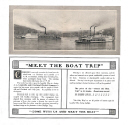THE LOUISVILLE & CINCINNATI PACKET CO.
The Steamer America seen below started out as the Indiana. Built in 1900 by the Howard Ship Yard in Jeffersonville, Indiana for the Louisville & Cincinnati Packet Co. She drew only 30" and replaced the City of Louisville (below) in times of low water. This boat never ventured below Louisville. She caught fire on May 1, 1916 at the Cincinnati Landing and was partially burned (see 2nd image, not a postcard). After being rebuilt at the Howard Yard she was renamed the America. Laid up above Jeffersonville, Indiana, for the winter of 1930, she burned once again. Arson was suspected.


The Steamer America
Indiana after fire.
at foot of Main
St.
The Betsy Ann was built in 1899 in Dubuque, Iowa. The boat was named for the original owners wife. She ran the Natchez-Bayou Sara trade and carried the U.S. Mail. Sold in 1921 for the Pittsburgh-Portsmouth run and then the Pittsburgh-Cincinnati trade. In 1925 Frederick Way Sr., and Jr., bought stock in her and ran the Pittsburgh-Cincinnati run until 1929. She then ran several different routes from Pittsburgh from 1930 through 1931. She is best remembered for her races against the Chris Greene (1928), and the Tom Greene (1929 & 1930). This led to the rebirth of the steamboat racing tradition.

The Steamer Betsy Ann Back of card on the leftThese are not postcards



Cabin-1923 Cabin-1929 Betsy Ann-1930 Captain Fred Way
(White shirt)
She was sold in 1932 and began towing barges. She was dismantled in St. Louis in 1940. The hull was used by the Wood River Refining Co., at Wood River. She was than sold to the Meramec Power boat Club. It struck the Merchants Bridge, in St. Louis, head-on but continued on to her destination on the Meramec River. Boat Club facilities were built and she was used until 1952-53 when it was beached due to the river falling and was sunk.
These are not postcards



Used as tow
boat-1938
Yacht
dock-1946
Final fate-1952-53
The Louisville & Cincinnati Packet Co. boats can always be easily spotted because they are always seen with two white stripes on their smoke stacks, until after the destruction of the fleet in the 1917-1918 ice jam, when the company was bought by new owners and the white collar symbol on the stacks were abandoned. The Image below shows the entire fleet except for the City of Madison in a very rare picture. The company dominated the Cincinnati to Louisville river route from just after the Civil War until packet service was suspended in 1933.
THE CITY OF CINCINNATI
The City of Cincinnati was part of the Louisville & Cincinnati Packet Co. fleet. This packet boat was built in 1899 at the Howard Ship Yard in Jeffersonville, Indiana. She was built expressly for the Louisville-Cincinnati trade, working in tandem with her sister ship, the City of Louisville (built in 1894) seen below. Both boats were built for freight and overnight passenger service with 72 staterooms, and an excursion capacity permit for 1,500 passengers. Both boats were destroyed in the 1918 Ice Gorge disaster (see Disaster Section.) The 3rd card is not only misidentified it is misspelled.


Main cabin-1900 (not a postcard)
CITY OF LOUISVILLE
Sister ship to the Cincinnati the City of Louisville was referred to as "the big boat." She set speed records for the route that were never bettered.
Not a postcard




The City of Louisville
pantry-1897
COMPLETE PACKET CO. BROCHURE





Front
Page
1
Page
2
Page
3
Page 4 Page 5




Page 6
Page
7
Page 8 Page
9
Page 10 Page
11 Page 12




Page
13
Page 14 Page
15 Page
16
Back
CINCINNATI
The all steel steamer Cincinnati was built in 1924 for the
Cincinnati & Louisville Packet Co. She was a steel-hulled boat that was
built to replace the earlier wood-hulled boats that had been destroyed by the
great ice gorge or 1918. It was considered the most modern craft on
an American river. It was radio equipped, had an orchestra, social hostesses,
there were 40 waiters and 12 men in the kitchen, etc. It was nearly 300 feet long and 85 feet wide. It had hot and cold running
water in every extra large stateroom. She was sold in 1933 when pulled from
packet service and renamed the Str. President with a completely different
top structure. She later became an excursion boat, a gambling boat and then was
converted to diesel power in 1978.
The original plan had been to build two Str. Cincinnati style boats but because the cost of building the Cincinnati was so over budget
at $417,000 the hull of the 2nd would-be Louisville was sold to the Coney Island
Company and she became the 2nd Island Queen.
Below is a series of photographs that are from the souvenir book that was put out for the dedication of this steamer. The 3rd image is not from the brochure but it is obviously the same photograph.




Passengers on maiden
voyage
Main Cabin &
Mezzanine
Lounging
Room



Parlor
Stateroom
Dining
Saloon
Kitchen